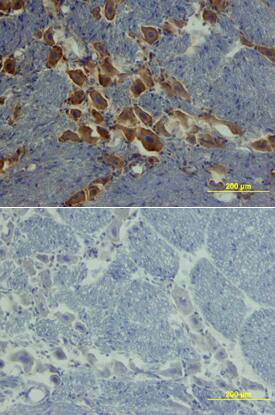Rat ROBO1 Antibody
R&D Systems, part of Bio-Techne | Catalog # AF1749


Key Product Details
Species Reactivity
Validated:
Cited:
Applications
Validated:
Cited:
Label
Antibody Source
Product Specifications
Immunogen
Lys19-Ile560
Accession # O55005
Specificity
Clonality
Host
Isotype
Scientific Data Images for Rat ROBO1 Antibody
ROBO1 in Rat Embryo.
ROBO1 was detected in immersion fixed frozen sections of rat embryo (neural tube) using 5 µg/mL Goat Anti-Rat ROBO1 Antigen Affinity-purified Polyclonal Antibody (Catalog # AF1749) overnight at 4 °C. Tissue was stained with the Anti-Goat HRP-DAB Cell & Tissue Staining Kit (brown; Catalog # CTS008) and counterstained with hematoxylin (blue). View our protocol for Chromogenic IHC Staining of Frozen Tissue Sections.ROBO1 in Rat Brain.
ROBO1 was detected in perfusion fixed frozen sections of rat brain using Goat Anti-Rat ROBO1 Antigen Affinity-purified Polyclonal Antibody (Catalog # AF1749) at 15 µg/mL overnight at 4 °C. Tissue was stained using the Anti-Goat HRP-DAB Cell & Tissue Staining Kit (brown; Catalog # CTS008) and counterstained with hematoxylin (blue). Lower panel shows a lack of labeling if primary antibodies are omitted and tissue is stained only with secondary antibody followed by incubation with detection reagents. View our protocol for Chromogenic IHC Staining of Frozen Tissue Sections.Applications for Rat ROBO1 Antibody
Immunohistochemistry
Sample: Immersion fixed frozen sections of rat embryo (neural tube) and perfusion fixed frozen sections of rat brain
Western Blot
Sample: Recombinant Rat ROBO1 Fc Chimera (Catalog # 1749-RB)
Formulation, Preparation, and Storage
Purification
Reconstitution
Formulation
Shipping
Stability & Storage
- 12 months from date of receipt, -20 to -70 °C as supplied.
- 1 month, 2 to 8 °C under sterile conditions after reconstitution.
- 6 months, -20 to -70 °C under sterile conditions after reconstitution.
Background: ROBO1
Rat ROBO1 (also DUTT1) is a 170-200 kDa member of the four molecule ROBO family of guidance molecules (1-3). The term ROBO derives from round-about, a description of the circuitous pathway axons take in the absence of a functional ROBO gene (3, 4). Rat ROBO1 is a type I transmembrane (TM) glycoprotein that is synthesized as a 1651 amino acid (aa) precursor. It contains an 18 aa signal sequence, an 879 aa extracellular domain (ECD), a 21 aa transmembrane segment, and a 733 aa cytoplasmic region (5, 6). The ECD contains five C2-type Ig-like domains (aa 68-541) and three fibronectin (FN) type III domains (aa 561-864). The cytoplasmic region contains multiple 15-20 aa long CC (conserved cytoplasmic) motifs (C0-C3) (7, 8). Rat ROBO1 is likely to have at least one isoform. Based on the human and mouse gene, rat ROBO1 will utilize an alternate start site, creating an A (long) and B (short) isoform. The difference is the presence of a 32 aa extension at the N-terminus of the mature molecule (occurs in the A form) (9-12). Based on ROBO3 studies, this extension will impact the ability of ROBO1 to bind Slit (10). Rat ROBO1 ECD is 98% and 96% aa identical to the ECD in mouse and human ROBO1, respectively. ROBO1 serves as a repulsing molecule for axons that cross the midline. Initially, ROBO3 allows outgrowing axons to traverse the midline/floorplate. Once crossed, axons express ROBO1 which deflects neurites attempting to recross to the ipsilateral side (13). The chemorepulsant activity of ROBO1 is dependent on ROBO1 binding to SLIT1/2. Inhibition of ROBO1 is likely due to ROBO1-ROBO3 heterophilic binding (10, 13-15).
References
- Guthrie, S. (2001) Curr. Biol. 11:R300.
- Guthrie, S. (2004) Curr. Biol. 14:R632.
- Park, K.W. et al. (2003) Dev. Biol. 261:251.
- Seeger, M. et al. (1993) Neuron 10:409.
- Kidd, T. et al. (1998) Cell 92:205.
- Marillat, V. et al. (2002) J. Comp. Neurol. 442:130.
- Bashaw, G.J. et al. (2000) Cell 101:703.
- Jen, J.C. et al. (2004) Science 304:1509.
- Clark, K. et al. (2002) FEBS Lett. 523:12.
- Camurri, L. et al. (2005) Mol. Cell. Neurosci. 30:485.
- Sundaresan, V. et al. (1998) Mol. Cell. Neurosci. 11:29.
- GenBank Accession # O55005.
- Sabatier, C. et al. (2004) Cell 117:157.
- Liu, Z. et al. (2004) Mol. Cell. Neurosci. 26:232.
- Brose, K. et al. (1999) Cell 96:795.
Long Name
Alternate Names
Gene Symbol
UniProt
Additional ROBO1 Products
Product Documents for Rat ROBO1 Antibody
Product Specific Notices for Rat ROBO1 Antibody
For research use only
